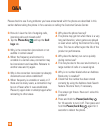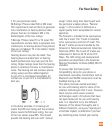
105
For Your Safety
kilogram, averaged over one gram of tissue.
Although the SAR is determined at the
highest power level, the actual SAR value
of a wireless phone while operating can
be less than the reported SAR value. This
is because the SAR value may vary from
call to call, depending on factors such as
proximity to a cell site, the proximity of the
phone to the body while in use, and the use
of hands-free devices. For more information
about SARs, see the FCC’s OET Bulletins
56 and 65 at http://www.fcc.gov/Bureaus/
Engineering_Technology/Documents/
bulletins or visit the Cellular Telecom-
munications Industry Association website
at http://www.ctia.org/consumer_info/
index.cfm/AID/10371. You may also wish to
contact the manufacturer of your phone.
Can I minimize my RF exposure?
If you are concerned about RF, there are
several simple steps you can take to
minimize your RF exposure. You can, of
course, reduce your talk time. You can place
more distance between your body and the
source of the RF, as the exposure level
drops off dramatically with distance. The
FDA/FCC website states that “hands-free
kits can be used with wireless phones for
convenience and comfort. These systems
reduce the absorption of RF energy in
the head because the phone, which is
the source of the RF emissions, will not
be placed against the head. On the other
hand, if the phone is mounted against
the waist or other part of the body during
use, then that part of the body will absorb
more RF energy. Wireless phones marketed
in the U.S. are required to meet safety
requirements regardless of whether they
are used against the head or against the
body. Either configuration should result in
compliance with the safety limit.” Also,
if you use your wireless phone while in a
car, you can use a phone with an antenna
on the outside of the vehicle. You should
also read and follow your wireless phone
manufacturer’s instructions for the safe
operation of your phone.
Do wireless phones pose any special risks
to children?
The FDA/FCC website states that “the
scientific evidence does not show a danger
to users of wireless communication devices,
including children.” The FDA/FCC website
further states that “some groups sponsored
by other national governments have advised
that children be discouraged from using
wireless phones at all”. For example, the
Stewart Report from the United Kingdom
[“UK”] made such a recommendation in
December 2000. In this report a group of
independent experts noted that no evidence
exists that using a cell phone causes
brain tumors or other ill effects. [The UK’s]
recommendation to limit cell phone use
by children was strictly precautionary; it


















